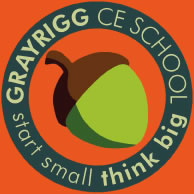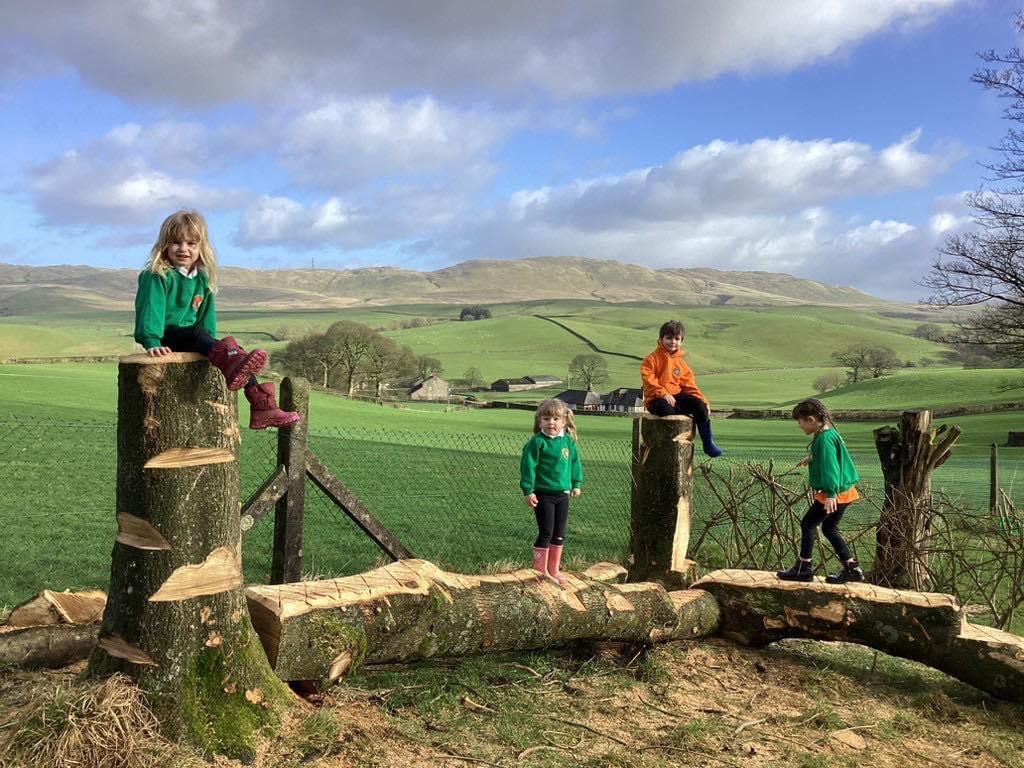Teaching and Learning at Grayrigg.
Inspiring, wobbling and building dry-stone walls!
Teaching is not about standing at the front of the class, it’s about providing opportunities for children to learn. Teaching is not about putting on a show every day from 8:45- 3:15. It is about the environment you create, the experiences you provide and how you guide the little people in your care through those experiences and opportunities ensuring they get as much as they (and the teacher) seize every moment to learn something new.
Of course, some of those opportunities may be less exciting than others but we promise every child that we will always endeavour to make lessons fun and memorable but also that every mile stone or piece of learning will lead us to the path where we can do the exciting things and change the world.
In the earlier years of education at Grayrigg, much of their learning is created through a carefully planned out environment, that gives children the opportunity to process the experiences they’ve already had and engage with new experiences. Their learning takes place in both the indoor and outdoor classrooms, as well as the forest classroom (at least weekly). The majority of the learning is inspired through hands on learning with direct focused teaching for daily phonics and maths as well as helicopter stories and drawing club!On Friday, from reception up, children participate in Big Write (or big draw). As they move into the Spring term, reception children are further challenged with weekly challenges where they begin to understand “WOBBLING.
As the children move through school into KS1, the teachers continue to develop learning through engaging experiences, focusing on independent challenge with the children beginning to understand the difference between too easy, challenging or too hard (the wobble)During the afternoons, the children engage in carefully planned challenges, some independent, some supported and some teacher led. The best way to understand the learning in KS1 is to read our headteacher’s KS1 blog here: http://www.grayrigg.cumbria.sch.uk/blog/ks1-indepe…
As they move through KS2, Children immerse themselves in longer topics focusing on one area over a few weeks rather than 1 hour a week. They begin to explore ways of researching, storing and presenting information, this is initially scaffolded for the Oaks class in year 3 and 4 - aiming for children in the Mighty Oaks (year 5 and 6) to be able to self challenge, recognise where they need to be slow and steady and where they can push themselves to shine and reach further than they ever though they could. .
Their learning continues to be inspired by experience, but also by the real, grown up world - working with experts as well as teachers, for example, dissecting lambs lungs and tracking the journey of oxygen from the bronchus to the alveolus with a local vet is an experience children never forget. The teacher’s role then becomes one of making the understanding relevant to children. When working with experts, the aim is not for children to merely engage in a question and answer session but, when possible, to use their expertise to engage in activities that will make their learning memorable.
Of course, experience and inspiration must be backed up with firm foundations in the required skills and knowledge to prepare them for life and learning beyond their primary years.
The Dry Stone Wall.
Whilst every teacher aims to inspire children they must first start with firm foundations. These are the skills required to progress in their learning. At Grayrigg we use the analogy of a dry stone wall when discussing the non-negotiables.
With dry stone walls, not every stone is the same size, but they are all important. In fact it is the stones nearer the bottom that are the most important. If a wall has gaps lower down, you can build it higher and higher but eventually it will collapse because its foundations are not strong. Learning is the same, pushing a child without the secure foundations required to understand new concepts and ideas, will lead to a collapsing wall.
At Grayrigg we definitely don’t want to build a child up to send them off to secondary school, only for their understanding to collapse when they move on to more complex learning. The national curriculum provides us with a list of non-negotiables which can be found on the skill progression grids/sheets for every year group, which they should be secure in by the end of the year. We keep a check on these throughout the school year and any child not becoming secure in them will be offered additional short term support to ensure no gaps are left. Children who are moving quickly are further challenged to ensure they have truly mastered the skills before moving on.
The Learning Journey and the Wobble.
If you look out of the windows at Grayrigg your eyes are met by the stunning view of Whinfell. This provides the perfect metaphor for every learning journey and is used with the children. If you look carefully at the view you can see the path up the hill (to the mast), this part of the walk up Whinfell is relatively easy, in fact it can be reached in a car. Just like learning, the journey starts off relatively simply, however, when you reach the mast the view isn’t spectacular. To see the spectacular view you have to keep going - the climb gets more challenging as at this point there are a few steeper sections and the children are tired - but if they push on, stick with it even when they want to give up, they will reach the top. It is only at the peak of Whinfell that you see the stunning view in all directions.
We refer to the part of the journey when it gets tricky as “the wobble” and we use this language in the classroom - to really learn that we should have a wobble, in fact it is the wobble that proves we are truly learning. Endurance is a core value at Grayrigg, the ability to keep going when it gets hard, not to give up. All teachers at Grayrigg are expected to discuss, embrace and celebrate the wobble with all children, at whatever point it comes. Every new achievement that has taken effort and stamina is celebrated, however small it may seem.
The learning journey is celebrated in stages.
Initial stage to learning is the JOY OF NOT KNOWING: children are encouraged to be comfortable with not knowing everything, to show humility and be able to admit that they do not know something and that this is exciting as it means we have an opportunity to learn. If a child is already and expert on a specific subject then the teacher will adapt the learning for this child to ensure they know they have something to learn.
We can then move on to diving into the learning, with courage knowing that we are all learning and we will all feel a wobble at some point.
We dive deep into the learning but to learn we have to get back out of the learning pit we have dived into, this is the wobble. The children know that they may have ot bounce up and down a few ties in the learning pit to get back out of the other side, they may need to climb slowly, they need a bit of help, they may find climbing out easy and therefore can use this to assist another child but they all know that with endurance and hope they will climb out of the other side.
It is important for the children to feel proud of themselves when they have wobbled before moving onto the next thing they don’t know because that is the JOY OF NOT KNOWING everything, there is also something new to learn.
Our Context, our curriculum
We’re fortunate to have a beautiful environment which we take full of advantage of with weekly forest schools sessions linked to the National Curriculum, encouraging children to put the device down and get outside and our new for 2024 River School. We are also able to take advantage of this through our PE curriculum engaging in outdoor activities. We also work hard to run our school values through our curriculum and a webinar and resources we were part of developing with chartered college as a lead school on the rethinking the curriculum project can be seen here. Our locality is stunning but lack human diversity, access to a wide range of museums and the arts so we have worked to complement this through city residentials, using technology to connect with artists. We surprised ourselves as we explored representation and who isn’t in the school and discovered that there is a little more to Cumbria than first meets the eye.




